|
|
|
|
|
|
|
AsianInfo
on Japan
Eating
in Japan
|
|
|
|
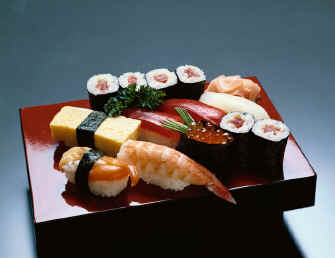
|
|
|
AsianInfo.org
supports I.C.E.Y. -
H.O.P.E. (non-profit org)
(International
Cooperation of Environmental Youth - Helping Our Polluted
Earth) Any advertisement you view helps save the
environment! Thanks! |
|
|
|
Sushi (Recipe)
|
Food in General
Food of all types and from every
country under the sun, is one of the great pleasures of
life in Japan. Not only has Japan developed one of
the world's great cuisines, which offers palate-tickling
sensations that range fro the subtle joys of
"sashimi" to the hearty basics of its noodles,
but some of the best world-class chefs have come to Japan
to cook for its discriminating gourmets. Tokyo
especially, as befits its status as a global capital of
finance and business, is host to a lip-smacking cornucopia
of food flavors and textures.
To begin scratching the surface of
Japan's vast selection of culinary variety, take a walk in
the vicinity of any subway or train station. The
eating and drinking establishments that congregate here
are sure to represent a plethora of domestic cooking, with
prices generally quite reasonable. For non-Japanese
speakers, some restaurants display plastic and wax
replicas of their dishes in their front windows, or
provide a menu with color photos.
Another good place to find
reasonable priced meals is in larger department stores,
which will often devote an entire upper or basement floor
to different restaurants. Some modestly priced
restaurants ask patrons to purchase tickets for each dish,
either from the cashier's counter or vending machine.
Tipping, by the way, is not practiced in Japan.
|
| Japanese Cuisine
Once known in the west either in the
form of "sukiyaki" or the more exotic
"sushi," Japanese cuisine has in recent years
become much more familiar and appreciated around the
world. Many visitors to Japan will have already
sampled the pleasures of raw fish or batter-fried shrimp.
But few first time visitors to Japan are prepared for the
variety and sumptuousness of the food as it is
traditionally prepared. Eating in Japan is an
experience to be enjoyed and remembered fondly for the
rest of your life.
Among the types of cooking found in
Japan are:
Sukiyaki -
prepared right at the table by cooking thinly sliced beef
together with various vegetables, tofu and vermicelli.
Tempura -
deep-fried food in vegetable oil, after being coated with
a mixture of egg, water and wheat flour. Among the
ingredients used are prawns, fish in season and
vegetables.
Sushi -
a small piece of raw seafood placed on a ball of vinegared
rice. the most common ingredients are tuna,
squid and prawn. Cucumber, pickled radish and sweet
egg omelette are also served.
Sashimi -
sliced raw fish eaten with soy sauce.
Kaiseki Ryori
-
regarded as the most exquisite culinary refinement in
Japan. The dishes are mainly composed of vegetables
and fish with seaweed and mushrooms as the seasoning base
and are characterized by their refined savor.
Yakitori -
made up of small pieces of chicken meat, liver and
vegetables skewered on a bamboo stick and grilled over hot
coals.
Tonkatsu -
a deep-fried pork cutlet rolled in bread crumbs.
Shabu-shabu -
tender, thin slices of beef held by chop-sticks and
swished in a pot of boiling water, then dipped in a sauce
before being eaten.
Soba and
Udon - two kinds of Japanese noodles. Soba is
made from buckwheat flour and Udon from dipped in a sauce,
and are available in hundreds of delicious variations.
Japanese "sake" or
rice wine, goes extremely well with a variety of Japanese
dishes. Brewed with rice and water, sake has been a
Japanese alcoholic beverage since ancient times.
Because it can be drunk warmed up, the
"feelings" come on more quickly and in winter it
warms the body. When drunk chilled, good sake has a
taste similar to fine-quality wine. There are local
sake breweries in every region across the country, which
make their respective characteristic tastes based on the
quality of rice and water as well as differences in
brewing processes.
Information
on Japanese cuisine provided by the Japanese Embassy
|
|
|
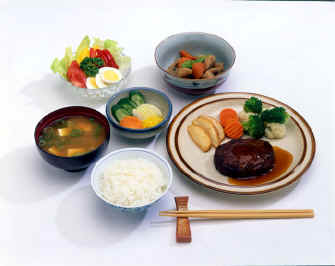
|
|
Food in
General
|
|
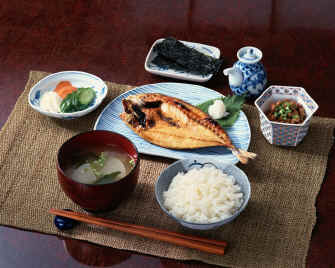
|
|
Food in
General
|
|
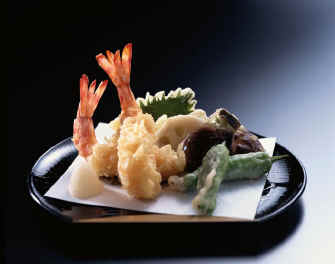
|
|
Tempura
|
|
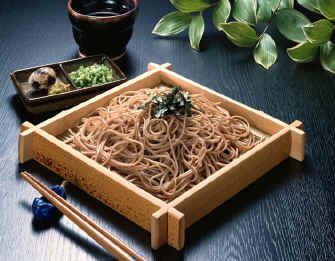
|
|
Soba
|
How
to Make Sushi
Things you'll
need:
Most can be found at an Asian market if
your local grocery store doesn't carry them. If you
go to an Asian market, tell them you are going to make
sushi and they will help you get the right items. Japanese
and Korean Asian markets are the best places to purchase
these items (not Chinese).
rice (short
or medium grain) - needs to be ready first
rice vinegar (or white vinegar)
sugar
salt (or sea salt, preferred)
water
roasted seaweed (laver or
yakisushi nori - different names for roasted seaweed)
sharp knife
plastic wrap
cutting board
plastic gloves
bamboo mat (optional, for
rolling sushi)
rice cooker (Japanese
or Korean rice cookers are the best types)
Fillings
/ condiments (choose
all or some)
The most popular
ingredients for the california roll are avocado, imitation
crab meat, and roe. Other ingredients can be added
according to your preferences / tastes.
avocado -
Find a soft but firm avocado (leaves an indention when
pressed) . It needs to be peeled, seeded and cut
into strips (lemon may be rubbed
on avocado to prevent browning)
cucumber - peeled, seeded and cut into strips
imitation crab meat
carrots - peeled and sliced or grated very thin
egg(s) - cook scrambled egg(s) into a thin omelette
and cut into strips (it is usually used in Korean style
sushi called kimbap)
tempura (fried fish cake) - cut into strips (it
is usually used in Korean style sushi called kimbap)
pickled radish (usually yellow or white) - if
whole, cut into long strips (or
can be purchased pre-cut) (it
is usually used in Korean style sushi called kimbap)
roe (fish eggs) - usually orange
wasabi - pre-prepared in a tube or powder form.
If powder form, add water to make
thick paste - tube form is easier to use and lasts longer.
soy sauce - Japanese style mild soy sauce (add
water to decrease saltiness)
pickled ginger - usually thinly sliced and can be
pink, red, or natural color
toasted sesame seeds (whole)
The Process:
-
Cook rice in rice
cooker or pot. It is really important to have
the right ratio of rice to water. If there is
too much water, it will mushy and too soft. If
there is not enough water it will be too hard and dry.
A general estimate is 1 cup rice to 1 1/2 cup water,
but it depends on the heat source that's being used.
The way to have the best rice is to use (buy) a rice
cooker and follow the directions. It usually has
perfect rice every time. If a rice cooker is not
available, try cooking in a pot with the above
measurements (1 cup of rice per 1 1/2 cups of water).
Cook rice (covered) on high until it boils rapidly,
then turn down heat to middle or low until cooked.
DO NOT open the lid too often or the rice will dry
out. If you smell a slight
scorched smell, test the rice to make sure it's soft
enough. It is a good idea to rinse the rice until the
water runs clear and then soak for about two hours.
-
While rice is cooking
prepare the sushi vinegar - Mix 1 teaspoon (per cup of
rice cooked) vinegar, 1/2 teaspoon salt, 1 to 2
teaspoons sugar, 1 to 2 teaspoons water.
-
When rice is cooked,
mix with the sushi vinegar mixture (see above) and
IMPORTANT cool the rice quickly. (Don't use a
metal bowl, the vinegar reacts with it.) Use a
hand fan (or other fan) to cool it while
stirring rice. After rice is cool, taste it to
make sure it's seasoned well. The rice, if
prepared correctly, will have a glossy sheen and will
be chewy. It's it's too salty, add a little more
sugar. If too sweet, add a little more salt. The
vinegar smell will disappear as the rice cools.
Cover rice and prepare other ingredients.
- Peel avocado, seed and
slice it into 1/3 inch strips. Place in a bowl
or other container and, with plastic gloves on,
slightly mash the avocado with your fingers.
This prevents the avocado from falling out of the
sushi roll.
-
Peel cucumber and cut
in half. Remove the seeds by running your finger
down the middle (discard seeds) and cut into
long thin slices.
- Remove imitation crab
meat from package and plastic overwrap. If you
think the crab meat is too thick (big), cut it in half
(longways).
-
Remove seaweed (nori)
and cut the long side in half, so you have two pieces
from the one sheet.
- If the roe is frozen, it
needs to be thawed. Thirty minutes at room
temperature should be sufficient.
- Wet the cutting board
slightly (helps prevent the rice from sticking) and
put cooled, seasoned rice on a sheet of seaweed.
Wear plastic gloves to prevent your hands from
sticking to the rice. Put approximately a tennis
ball or baseball sized ball of rice on the nori.
Spread rice evenly, without handling it too much.
Sushi experts usually use six movements to cover the
seaweed with rice. Press the rice firmly to the
seaweed then lightly sprinkle with toasted sesame
seeds.
- Flip seaweed over so
that the rice is on the cutting board. The black
side is where the ingredients are placed, the rice is
the outer part of the roll.
- Place a few strips of
avocado in the center of the seaweed (long sideof
seaweed horizontally in front of you), then a few
strips of imitation crab meat and use a spoon to apply
roe.
- Fold the side of seaweed
closest to you over the avocado, crab meat and roe
then firmly fold the other side of the seaweed
(farthest from you) back over the roll. Shape
the roll gently with your hands (into a roll or
square). The rice will help the sides stick together.
- Slice the roll into 6 or
7 uniform pieces, using a wet cloth or bowl of water
to clean the knife. (So the rice doesn't stick
to knife)
- Transfer rolls to a
plate with some wasabi, soy sauce and ginger. Wasabi
can be mixed in the soy sauce - but be careful -
wasabi is VERY hot!
- Enjoy the wonder
Japanese cuisine - the California roll!
Once you become accustomed
to making these, use your imagination to create
one-of-a-kind delicacies! Sushi is food art, so let
your creative juices flow!
|
|
|
|
|
|
|
|









